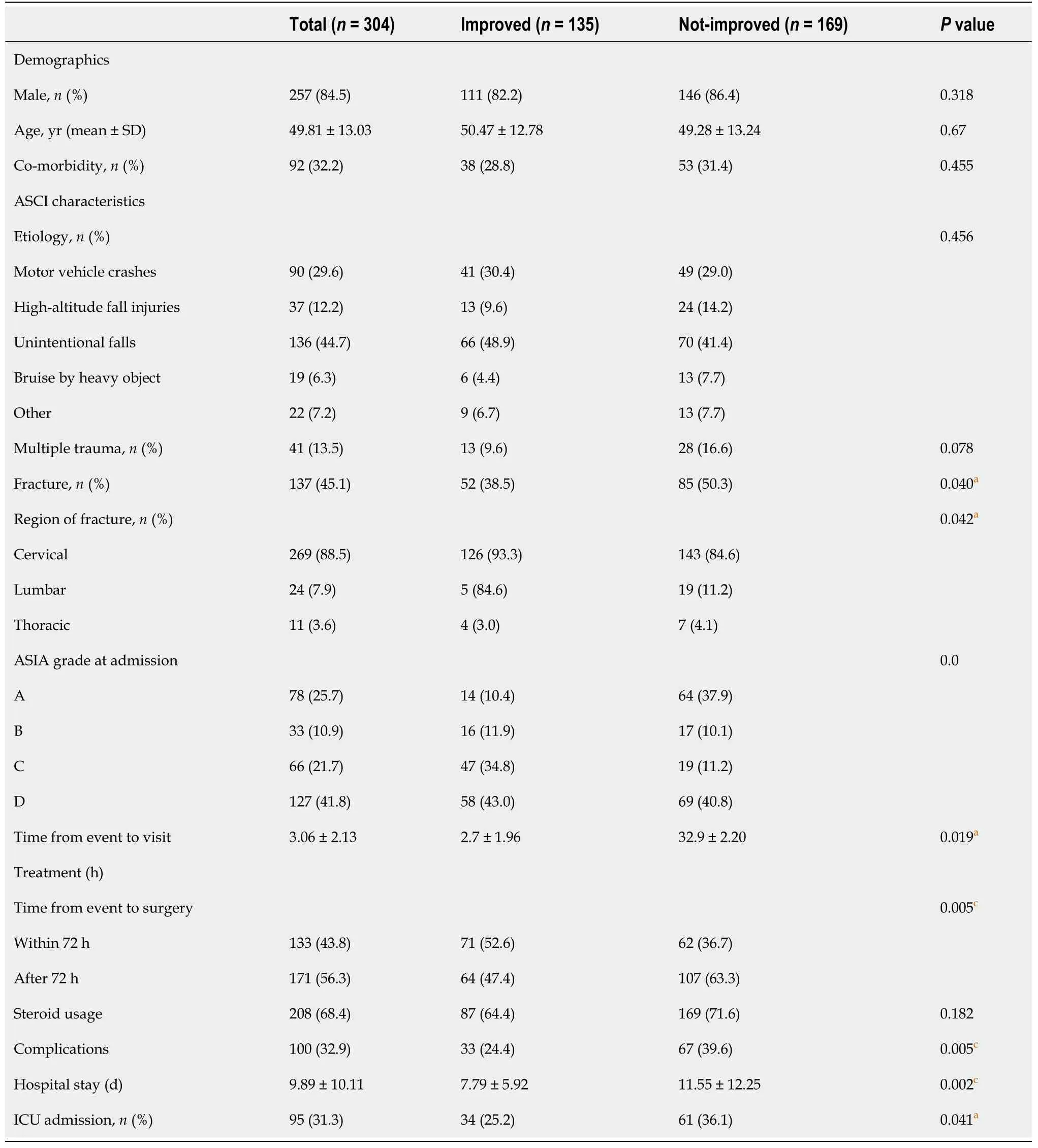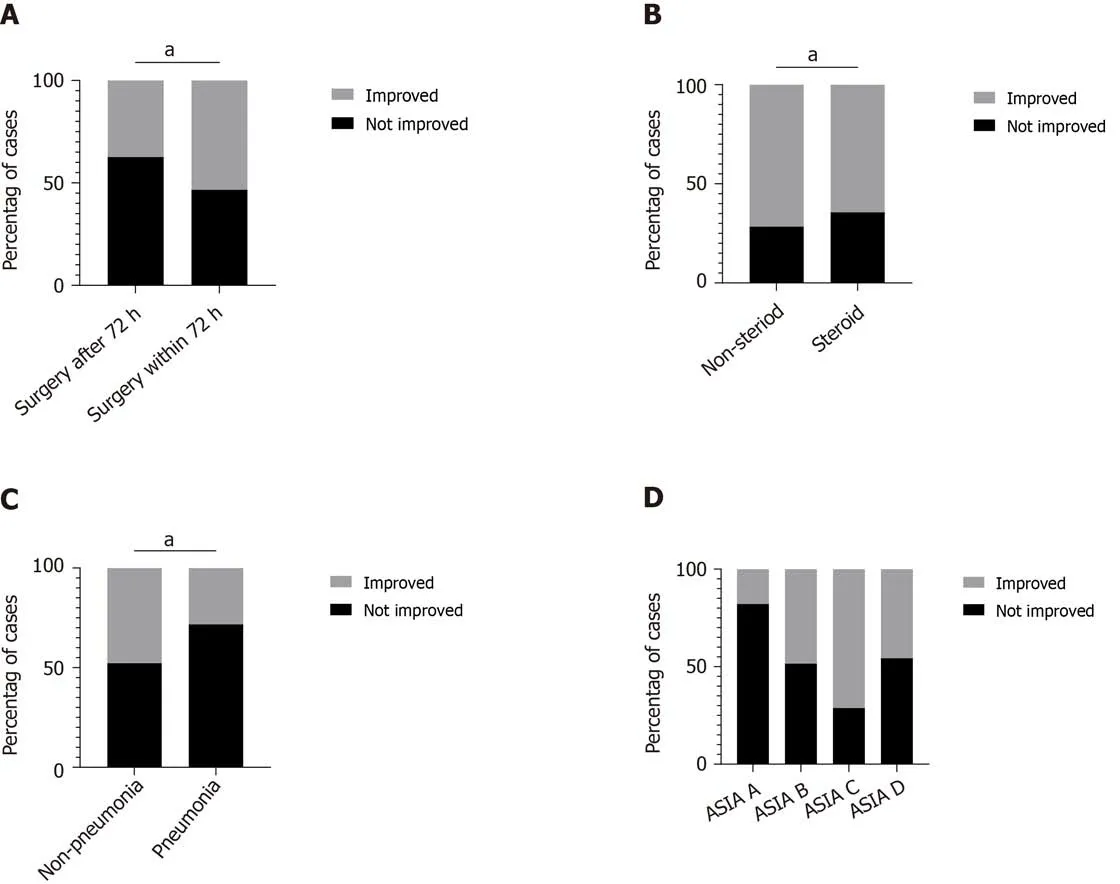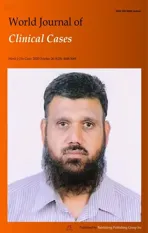Factors related to improved American Spinal Injury Association grade of acute traumatic spinal cord injury
2020-04-08CiTianYangLvShuLiDaiDaiWangYiBaiFangZhouQingBianMa
Ci Tian, Yang Lv, Shu Li, Dai-Dai Wang, Yi Bai, Fang Zhou, Qing-Bian Ma
Ci Tian, Shu Li, Dai-Dai Wang, Yi Bai, Qing-Bian Ma, Department of Emergency Medicine, Peking University Third Hospital, Beijing 100191, China
Yang Lv, Fang Zhou, Department of Orthopedics, Peking University Third Hospital, Beijing 100191, China
Abstract BACKGROUND Acute traumatic spinal cord injury (ATSCI) usually results in disability, yet data on contemporary national trends of ATSCI incidence are limited.AIM To provide a systematic and basic theoretical basis for improving the treatment of acute spinal cord injury.METHODS Data from the Peking University Third Hospital Inpatient Sample databases were analyzed. A total of 304 patients with ATSCI were included from 2012 to 2017.The epidemiological data, treatment, complications and clinical outcomes of these patients were reviewed.RESULTS Of the 304 patients, 257 (84.5%) were male, and 75% of the patients were 55 years old or younger. 135 patients had improved follow-up American Spinal Injury Association (ASIA) grades (44.4%). Only 14 patients with ASIA grade A improved. A statistically significant difference in prognosis between patients who underwent surgery within 72 h and those who underwent surgery after 72 h was observed (P < 0.05). Surgery within 72 h resulted in better prognosis. The Steroid group and the Non-Steroid group showed a significant difference in outcome among patients with ASIA grades A and B (P < 0.05). Patients with pneumonia had a poorer prognosis than patients without pneumonia (P < 0.05). Surgery within 72 h resulted in better prognosis.CONCLUSION This study found that there was no significant difference in hospitalization time and prognosis between the Steroid group and the Non-Steroid group, but the patients with severe spinal cord injury (ASIA grades A and B) who underwent surgery combined with steroid therapy had a better prognosis than those who underwent surgery alone. The disastrous consequences of ATSCI and lack of consensus on the management strategy are obvious. Further improvements in treatment planns are needed in order to obtain more reliable functional outcomes.
Key Words: Acute spinal cord injury; Trauma; Surgery; American Spinal Injury Association; Steroids; Prognosis
INTRODUCTION
Acute spinal cord injury (ASCI) is a common type of severe trauma in the emergency department, which results in catastrophic consequences for patients. The vast majority of patients are disabled due to severe neurological damage, or can even result in fatalities. This places an enormous financial burden and emotional stress on families and society.
The most recent model systems estimate of 12500 new cases per year was revised recently from 11000 new cases per year based on the increase in the United States population. The number of individuals with acute traumatic spinal cord injury(ATSCI) is increasing, mostly in young and middle-aged men[1]. Patients get paralyzed or even die, causing huge medical and economic burdens on families and society.
Research in this area is extensive, including the continuous improvement in surgical techniques and protocols, the clinical application of hormones, clinical research on drugs to protect and promote nerve growth, and the exploration of emerging stem cell transplantation treatments,etc[2-7]. However, there is currently no mature and effective measures that can improve the patient's functional outcome[8,9].
This article reviews the epidemiology and treatment of patients with ATSCI in our hospital over the past 5 years, in order to provide a systematic and basic theoretical basis for improving the treatment of ASCI.
MATERIALS AND METHODS
A single-center retrospective cohort study was conducted in an urban tertiary hospital.Patients with ATSCI were recruited from 2012 to 2017 using the following inclusion and exclusion criteria: (1) Age > 18 years old; (2) ASCI diagnosed based on American Spinal Injury Association (ASIA) criteria; (3) ASIA grade A to D; and (4) Surgical intervention during hospital stay. Patients with acute cerebrovascular disease were excluded. The patients were followed-up at one year after discharge, the ASIA score was recalculated, and the recovery of neurological function was evaluated according to the ASIA criteria.
Statistical data processing was performed using SPSS 22.0 (IBM Inc., Armonk, NY,United States). Analysis of variance (ANOVA) was used for measurement data. The ttest was used for quantitative data, and the Chi-square test was used for categorical data.P< 0.05 was considered statistically significant.
RESULTS
Patient demographics and clinical characteristics
There were 440 ATSCI patients enrolled in the study. A total of 304 cases were included in the final analysis (Figure 1). Patient demographics are shown in Table 1.
ATSCI was more common among young and middle-aged men. The most common injury site was the cervical spinal cord. Falls and motor vehicle crashes were the two most common causes. The study found that patients with fracture had a worse prognosis than patients without fracture (P< 0.05). A shorter time from onset to treatment resulted in a better prognosis (P< 0.05).
In addition to preventive antibiotic therapy, other treatments such as proton pump inhibitors (PPIs), nutritional supplements and analgesia were administered. All patients underwent surgical treatment with 133 patients undergoing surgery within 72 h. 208 patients were treated with steroids (Table 2), and 44 patients were treated with high-dose steroids. 243 patients were treated with mannitol.
There was no significant difference in mean hospitalization days or length of intensive care unit stay between the Steroid group and the Non-Steroid group (P>0.05). There were no significant differences in the average number of hospitalization days and prognosis between the high-dose steroid group and the low-dose steroid group (P> 0.05).
Complications
There was a difference in the prognosis between patients with complications and those without complications (P< 0.05). The presence of complications during hospitalization was documented, and included 53 cases of pneumonia, 37 cases of electrolyte disorder,30 cases of liver injury, 19 cases of tracheotomy, 17 cases of lower extremity deep venous thrombosis, 7 cases of urinary tract infection, 6 cases of stress ulcer, 4 cases of pulmonary embolism, 3 cases of hematoma, 1 case of acute myocardial infarction, 1 case of heart failure, and 1 case of cerebrospinal fluid leakage (Figure 2). The presence of a significant association between common complications and steroid use is shown in Table 3.
Of the 304 patients, 135 patients had improved follow-up ASIA grades (44.4%).Only 14 patients with ASIA grade A improved. There was a statistically significant difference in prognosis between patients who underwent surgery within 72 h and those who underwent surgery after 72 h (P< 0.05, Figure 3A). There were significant differences between the Steroid group and the Non-Steroid group only among patients with ASIA grades A and B (P< 0.05, Figure 3B). However, the incidence of pneumonia increased with steroid treatment (P< 0.05, Table 3). Patients with pneumonia had a worse prognosis than patients without pneumonia (P< 0.05, Figure 3C). Additionally,patients with an ASIA grade of A had the worst prognosis compared with other patients (P< 0.05, Figure 3D).
DISCUSSION
ATSCI severely affects daily life. The incidence of ATSCI is more common in young and middle-aged males. The cervical spine is the most commonly injured site.Frequent causes of injury are falls and traffic accidents. Becket al[10]found that there were 706 cases of ATSCI, most of which were the result of transportation accidents or falls. The incidence of ATSCI resulting from falls increased by 9%/year (95%CI: 4%-15%). In the present study, of 304 patients, 44.4% had improved neurological function.Only 14 patients with ASIA grade A improved. The improvement rate was 17.9%. Of these patients, 5 improved from grade A to grade B, 6 improved from grade A to grade C, and 3 improved from grade A to grade D. None of these patients had normal neurological function at one-year follow up. At present, the guidelines and consensus indicate that surgery is an effective means of treating ASCI and that surgery can alleviate the symptoms of nerve compression. However, there are no standard oreffective treatments for improving functional outcomes in these patients.

Table 1 Demographics and clinical characteristics of patients
Our study found that patients with fracture and dislocation had a poorer prognosis than patients without fracture or dislocation, as these patients usually had complications such as spinal cord compression and thus the injury was severe. The shorter the time from onset to treatment (including surgery within 72 h and medication), the better the neurological prognosis might be. Yanget al[11]found that high-dose steroid therapy within 8 h and adequate spinal decompression after injury can effectively improve spinal cord function in thoracolumbar spinal injury. Prognosis was closely related to the timely treatment of patients in the early stage of the injury and the reduction of spinal cord compression. In addition, fewer complications indicated a better neurological prognosis. Patients with pneumonia had a worseprognosis. Houet al[12,13]found that ASIA and moderate to severe respiratory complications were variables significantly correlated with tracheostomy. Jajaet al[14]found that pneumonia, wound infections, and sepsis (PWS) were the leading causes of acute mortality after ATSCI. Furthermore, as steroids can inhibit inflammation and reduce edema, they were often used as the first-line treatment in ATSCI[15]. However,the American Association of Neurological Surgeons has proposed guidelines issued in 2013 opposing the use of methylprednisolone as a routine treatment for ATSCI[16]. In recent years, an increasing number of clinical studies have shown that steroids have limited effects and benefits in ATSCI, and the use of high doses of steroids may cause serious complications, including gastrointestinal hemorrhage and respiratory tract
infection[17-20]. Our study found that the prognosis of patients treated with surgery combined with steroid therapy was not significantly different from those treated with surgery alone, while patients with severe spinal cord injury (ASIA grade B patients)had an improved prognosis. However, the incidence of infections caused by steroids may increase.

Table 2 Steroid treatment

Table 3 Complications in the Steroid group and Non-Steroid group

Figure 1 Enrollment and randomization of patients. ASIA: American Spinal Injury Association.

Figure 2 Complications in the study population.
This study was limited by the long course of spinal cord injury, slow recovery of neurological function, low improvement rate of the disastrous consequences of ATSCI and the current lack of mature treatments. Further improvements in the treatment plans are needed in order to preserve neurological function in patients. In addition, we also need to actively carry out randomized multicenter studies with improved sample size to provide more clinical evidence for the optimal management strategy in ATSCI patients.
CONCLUSION
Our study described the current clinical management of ATSCI patients with longterm follow-up and the findings of this study have important implications for future clinical practice. Surgery within 72 h resulted in a better prognosis. It was found that there was no significant difference in hospitalization time and prognosis between the Steroid group and the Non-Steroid group. However, patients with severe spinal cord injury (ASIA grades A and B) who underwent surgery combined with steroid therapy had a better prognosis than those who underwent surgery alone. The disastrous consequences of ATSCI and the lack of consensus on treatment require further study to improve the treatment strategy in order to obtain more reliable functional improvement.

Figure 3 Analysis of prognostic follow-up. A: Prognosis between surgery within 72 h and surgery after 72 h (aP < 0.05); B: Prognosis between the Steroid group and the Non-steroid group in American Spinal Injury Association (ASIA) A and B patients (aP < 0.05); C: Prognosis between the non-pneumonia group and the pneumonia group (aP < 0.05); D: Prognosis of patients with different ASIA grades on admission (P < 0.05). ASIA: American Spinal Injury Association.
ARTICLE HIGHLIGHTS
Research background
Acute spinal cord injury is a common type of severe trauma in the emergency department, and can have catastrophic consequences in patients.
Research motivation
To describe the present treatment of acute traumatic spinal cord injury (ATSCI) and provide important suggestions for future clinical practice.
Research objectives
The objective of our study was to provide a systematic and basic theoretical basis for improving the treatment of ATSCI.
Research methods
This retrospective study enrolled patients with ATSCI from 2012 to 2017, and recorded their demographic and clinical characteristics. Patients were followed-up at one year after discharge. The American Spinal Injury Association (ASIA) score was recalculated,and the recovery of neurological function was evaluated according to ASIA guidelines.
Research results
A total of 440 ATSCI patients were enrolled in our study, and 304 of these patients were included in the final analysis. The results of the analysis indicated that ATSCI was more likely to occur in young and middle-aged males and the cervical spinal cord was the most commonly injured site. A statistically significant difference in prognosis was observed between patients who underwent surgery within 72 h and those who underwent surgery after 72 h (P < 0.05). A significant difference between the Steroid group and the Non-Steroid group in terms of outcome was noticed in the ASIA grade A and B subgroups (P< 0.05). In addition, patients with pneumonia had a worse prognosis when compared with those without pneumonia (P< 0.05).
Research conclusions
Our study described the current situation in ATSCI patients with long-term follow-up and the findings in our study have important implications for future clinical practice.Surgery within 72 h resulted in a better prognosis. This study found that there was no significant difference in hospitalization time and prognosis between the Steroid group and the Non-Steroid group. However, patients with severe spinal cord injury (ASIA grades A and B) who underwent surgery combined with steroid therapy had a better prognosis than those who underwent surgery alone. The consequences of ATSCI are disastrous and there is still a lack of consensus on treatment. We need to further improve the treatment strategy in order to obtain more reliable functional improvement.
Research perspectives
This research area requires randomized multicenter studies with a larger sample size to provide more clinical evidence for the optimal management strategy in ATSCI patients to achieve a better prognosis.
杂志排行
World Journal of Clinical Cases的其它文章
- Relationship between non-alcoholic fatty liver disease and coronary heart disease
- Remission of hepatotoxicity in chronic pulmonary aspergillosis patients after lowering trough concentration of voriconazole
- Endoscopic submucosal dissection as alternative to surgery for complicated gastric heterotopic pancreas
- Observation of the effects of three methods for reducing perineal swelling in children with developmental hip dislocation
- Predictive value of serum cystatin C for risk of mortality in severe and critically ill patients with COVID-19
- Sleep quality of patients with postoperative glioma at home
